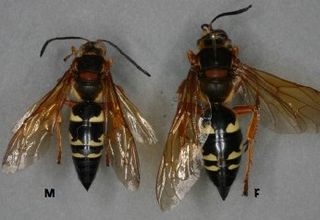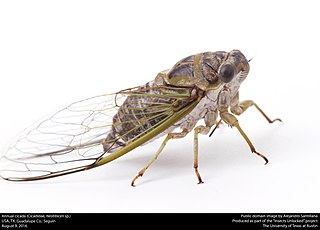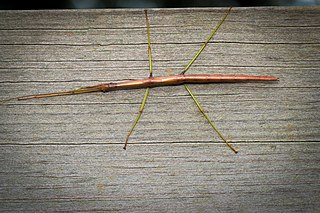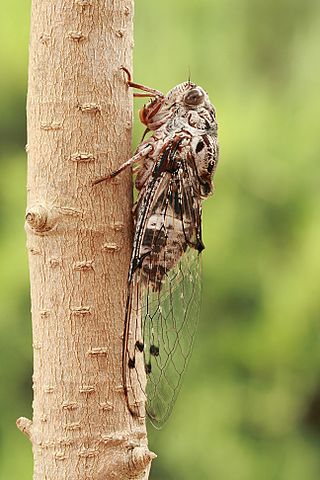
The cicadas are a superfamily, the Cicadoidea, of insects in the order Hemiptera. They are in the suborder Auchenorrhyncha, along with smaller jumping bugs such as leafhoppers and froghoppers. The superfamily is divided into two families, the Tettigarctidae, with two species in Australia, and the Cicadidae, with more than 3,000 species described from around the world; many species remain undescribed. Nearly all of cicada species are annual cicadas with the exception of the few North American periodical cicada species, genus Magicicada, which in a given region emerge en masse every 13 or 17 years.

Hemiptera is an order of insects, commonly called true bugs, comprising over 80,000 species within groups such as the cicadas, aphids, planthoppers, leafhoppers, assassin bugs, bed bugs, and shield bugs. They range in size from 1 mm (0.04 in) to around 15 cm (6 in), and share a common arrangement of piercing-sucking mouthparts. The name "true bugs" is often limited to the suborder Heteroptera.

Vitex agnus-castus is a plant native of the Mediterranean region. It is one of the few temperate-zone species of Vitex, which is on the whole a genus of tropical and subtropical flowering plants. Vitex is a cross-pollinating plant, but its self-pollination has been recorded.

The term periodical cicada is commonly used to refer to any of the seven species of the genus Magicicada of eastern North America, the 13- and 17-year cicadas. They are called periodical because nearly all individuals in a local population are developmentally synchronized and emerge in the same year. Although they are sometimes called "locusts", this is a misnomer, as cicadas belong to the taxonomic order Hemiptera, suborder Auchenorrhyncha, while locusts are grasshoppers belonging to the order Orthoptera. Magicicada belongs to the cicada tribe Lamotialnini, a group of genera with representatives in Australia, Africa, and Asia, as well as the Americas.

Sphecius speciosus, the eastern cicada-killer wasp, is a large, solitary digger wasp species in the family Bembicidae. They are so named because they hunt cicadas and provision their nests with them. Cicada killers exert a measure of natural control on cicada populations, and as such, they may directly benefit the deciduous trees upon which the cicadas feed. Sometimes, they are erroneously called sand hornets, despite not truly being hornets, which belong to the family Vespidae.

Cicadidae, the true cicadas, is one of two families of cicadas, containing almost all living cicada species with more than 3,200 species worldwide.

Leafhopper is the common name for any species from the family Cicadellidae. These minute insects, colloquially known as hoppers, are plant feeders that suck plant sap from grass, shrubs, or trees. Their hind legs are modified for jumping, and are covered with hairs that facilitate the spreading of a secretion over their bodies that acts as a water repellent and carrier of pheromones. They undergo a partial metamorphosis, and have various host associations, varying from very generalized to very specific. Some species have a cosmopolitan distribution, or occur throughout the temperate and tropical regions. Some are pests or vectors of plant viruses and phytoplasmas. The family is distributed all over the world, and constitutes the second-largest hemipteran family, with at least 20,000 described species.

William Lucas Distant was an English entomologist.

The Waterberg is a mountainous massif of approximately 654,033 hectare in north Limpopo Province, South Africa. The average height of the mountain range is 600 m with a few peaks rising up to 2,000 m above sea level. Vaalwater town is located just north of the mountain range. The extensive rock formation was shaped by hundreds of millions of years of riverine erosion to yield diverse bluff and butte landform. The ecosystem can be characterised as a dry deciduous forest or Bushveld. Within the Waterberg there are archaeological finds dating to the Stone Age, and nearby are early evolutionary finds related to the origin of humans.

The common walkingstick or northern walkingstick is a species of phasmid or stick insect found across North America. The average length of this species is 75mm (3 in) for males and 95mm (3.7 in) for females.

Massospora cicadina is a fungal pathogen that infects only 13 and 17 year periodical cicadas. Infection results in a "plug" of spores that replaces the end of the cicada's abdomen while it is still alive, leading to infertility, disease transmission, and eventual death of the cicada.

Machaerotidae are a family of bugs in the superfamily Cercopoidea which were formerly placed within Cercopidae. They are sometimes called tube-forming spittle-bugs as the nymphs form a calcareous tube within which they live. These bugs are mainly found in the Old World tropics. The adults of many genera have a long, free and spine-like process originating from the scutellum and thus superficially similar to the tree-hoppers, Membracidae. The tegmen or forewing, like typical bugs of the suborder Heteroptera, always has a distinct, membranous apical area.

Aleeta is a genus of cicadas with the only species Aleeta curvicosta, one of Australia's most familiar insects. Native to the continent's eastern coastline, it was described in 1834 by Ernst Friedrich Germar.

Psaltoda plaga is a species of cicada native to eastern Australia, from Maryborough in central Queensland to Bega in southern New South Wales. Adult cicadas appear over the summer and inhabit forested areas near bodies of water. The predominantly black form from the Sydney and Central Coast regions is commonly known as the black prince, while the term silver knight is used for the species as a whole.

Rhabdotis albinigra is a species of Scarabaeidae, the dung beetle family. It was described by Hermann Burmeister in 1847.

Euterpnosia is a genus of cicada native to the island of Formosa, the Ryukyu Archipelago, Japan, Hainan and mainland Asia - China, Bhutan, Nepal and Vietnam. The type species is Euterpnosia chibensisMatsumura, 1917. Until 2013 this genus was placed in the subtribe Leptopsaltriina, but is now considered typical of the Euterpnosiina Lee, 2013.

Tibicen is a former genus name in the insect family Cicadidae that was originally published by P. A. Latreille in 1825 and formally made available in a translation by A. A. Berthold in 1827. The name was placed on the Official Index of Rejected and Invalid Generic Names in Zoology by the International Commission on Zoological Nomenclature in 2021. Certain European cicada species that were included by some authors in this genus at the time of its suppression are now listed under genus Lyristes Horváth, 1926. Other formerly-Tibicen species are placed in the tribe Cryptotympanini and include the genera Auritibicen Lee, 2015, Hadoa Moulds, 2015 Megatibicen Sanborn and Heath, 2016, and Neotibicen Hill and Moulds, 2015.

Hyalessa maculaticollis is a species of cicada found in Northeast Asia in the order Hemiptera.

Carlisis wahlbergi aka the Gardenia twig wilter is a Central and Southern African species of Coreidae in the order Hemiptera. The species was first described by Carl Stål, the Swedish authority on Hemiptera, and based on a specimen collected by the Swedish naturalist Johan August Wahlberg at Lake Ngami in Bechuanaland.

Chremistica ochracea is a species of cicada in the suborder Auchenorrhyncha, which includes cicadas, leafhoppers, planthoppers, treehoppers, froghoppers and spittlebugs. They are usually referred to as 'thin winged cicada' in Taiwan and 'peaceful cicada' in China due to their abundance in these areas. They can be identified by their green appearance with thin, greenish, transparent wings and are heavily distributed in China, Taiwan, Japan, India and Malaya. However, there are limited number of scientific papers that describe the characteristics and behaviour of this species in detail.




















